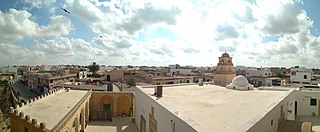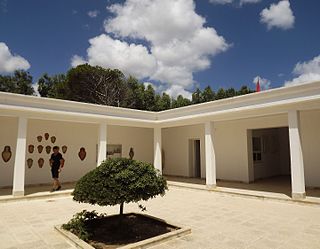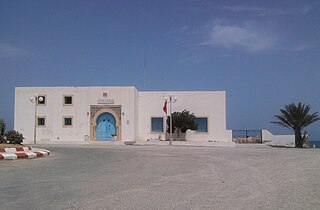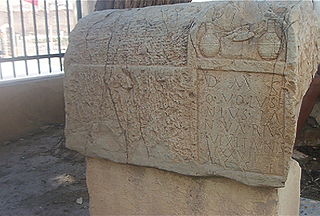
Lemta, historically Leptiminus, is a town in Tunisia with a history going back over 3,000 years.

El Djem or El Jem is a town in Mahdia Governorate, Tunisia. Its population was 21,576 during the 2014 census. It is home to Roman remains, including the Amphitheatre of El Jem.

The Bardo National Museum is a museum of Tunis, Tunisia, located in the suburbs of Le Bardo.

Gafsa Archaeological Museum is an archaeological museum in Gafsa, Tunisia. It sits in the old city center. Opposite the museum are ancient Roman pools.

Kerkouane Archaeological Museum is an archaeological museum located in Kerkouane, Tunisia. It contains statuary, jewelry and ceramic art.

The Lamta Archaeological Museum is an archaeological museum located in Lamta, Tunisia.

The Salakta Archaeological Museum is a Tunisian archaeological museum, located in Salakta. Established in 1980, it includes archaeological works from the ancient Sullectum, especially terra cotta, a mosaic pavement representing a gigantic African lion, and amphorae from other sites in the Sahel, Tunisia.
The Sfax Archaeological Museum is an archaeological museum located in Sfax, Tunisia.

The Sousse Archaeological Museum is an archaeological museum located in Sousse, Sousse Governorate, Tunisia.

The Carthage Paleo-Christian Museum is an archaeological museum of Paleochristian artifacts, located in Carthage, Tunisia. Built on an excavation site, it lies above the former Carthaginian basilica.

The Bulla Regia Museum is an archaeological museum in Bulla Regia, Tunisia.

The Chemtou Museum is an archaeological museum located in Chemtou, Tunisia. The museum was designed by archaeologists with the Tunisian National Heritage Institute and the German Archaeological Institute with offices located in Rome, Italy. It has the distinction of being located in the area of the old Roman city of Simmithu, near the entrepot's marble quarry in what was the ancient Berber kingdom of Numidia.
Dahmani, formerly Abbah Quşūr, is a town and commune in the Kef Governorate, Tunisia. As of 2004 it had a population of 14,061. It is located at 625 meters above sea level, 225 kilometers southwest of Tunis.
Bir Salah is a town and commune in the Sfax Governorate, Tunisia, between El Djem and El Hencha. As of 2004 it had a population of 4,638.
Jebiniana is a town and commune in the Sfax Governorate, Tunisia.
Sidi El Hani is a town and commune in the Sousse Governorate, Tunisia located at 35.67n, 10.30e. As of 2004 it had a population of 3,058. It gives its name to the largest lake of the governorate, a natural salt lake or salt pan (sabkha) in dry seasons, the Sebkhet de Sidi El Hani which is shared with between one and two other areas depending on precipitation and its maximum extent forms the official boundary with part of a third, Monastir Governorate. The town is 30 km south-west of the coast, its straightest connection being by Tunisian Railways, with a secondary connection by road, the P12 road which is a principal road to Kairouan from the A1 a few kilometres to the east. it is 19 km from Kairouan and 26 km from Raqqada.
The Mahdia Museum is a museum in Tunisia specialising in Tunisian archaeology and heritage. It is located in the city of Mahdia.

The Amphitheatre of El Jem is an oval amphitheatre in the modern-day city of El Djem, Tunisia, formerly Thysdrus in the Roman province of Africa. It is listed by UNESCO since 1979 as a World Heritage Site.
Bir el Menadla (Bir el Menadla) is a locality and archaeological site in Governorate de Mahdia (Al Mahdiyah), Tunisia (North Africa).


















